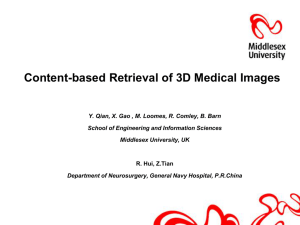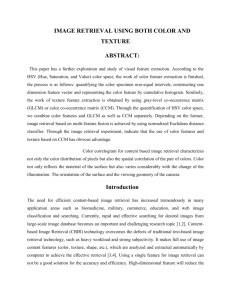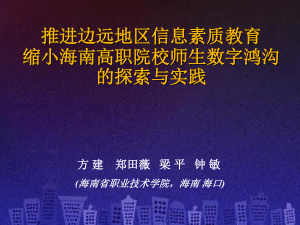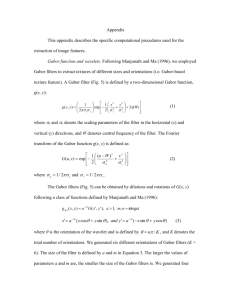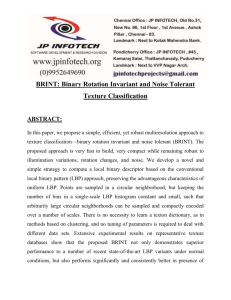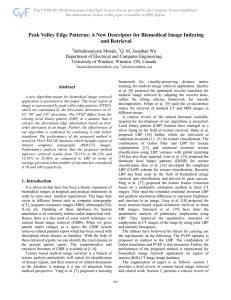PPT - Middlesex University
advertisement
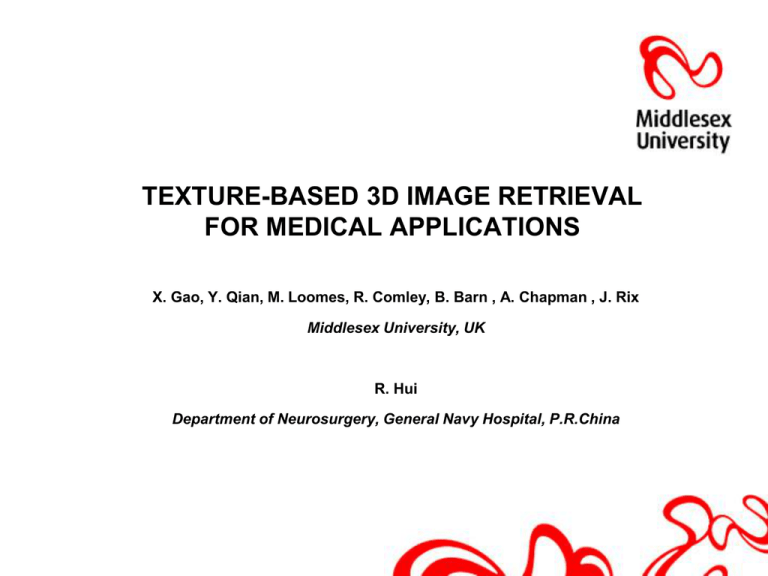
TEXTURE-BASED 3D IMAGE RETRIEVAL FOR MEDICAL APPLICATIONS X. Gao, Y. Qian, M. Loomes, R. Comley, B. Barn , A. Chapman , J. Rix Middlesex University, UK R. Hui Department of Neurosurgery, General Navy Hospital, P.R.China MIRAGE (Middlesex medical Image Repository with a CBIR ArchivinG Environment) Aim: To develop a repository of medical images benefiting MSc and research students in the immediate term and serve a wider community in the long term in providing a rich supply of medical images for data mining, to complement MU current online e-learning system. http://image.mdx.ac.uk/ JSIC Innovation in the use of ICT for education and research. http://www.jisc.ac.uk/ Proposed Framework for MRIAGE GIFT(GNU Image Finding Tool) GIFT is open framework for content-based image retrieval and is developed by University of Geneva. Query by example and multiple query Relevance Feedback Distributed architecture (Client - Server) MRML---C-S communication protocol Demo: GIFT Framework Framework of Content-Based Image Retrieval Texture-based 3D Brain Image Retrieval Current Content-Based Image Retrieval (CBIR) Content-based image retrieval system QBIC, Nectar, Viper, etc. Visual feature extraction from 2D image Content-based 3D Brain Image Retrieval Shape-based Proposed framework for 3D image retrieval 3D Texture Feature Extraction 1) 3D Grey Level Co-occurrence Matrices (3D GLCM) 2) 3D Wavelet Transform (3D WT) 3) 3D Gabor Transform (3D GT) 4) 3D Local Binary Pattern (3D LBP) 1) 3D Grey Level Co-occurrence Matrices (3D GLCM) 3D GLCM is two dimensional matrices of the joint probability of occurrence of a pair of gray values separated by a displacement d = (dx,dy,dz). 52 Displacement vectors: 4 distance * 13 direction = 52 4 Haralick texture features: energy, entropy, contrast and homogeneity Feature vector: 208 components (=4 (features) * 52 (matrices)). 2) 3D Wavelet Transform (3D WT) 3D WT provides a spatial and frequency representation of a volumetric image. 2 scales of 3D WT Mean and Standard deviation Feature vector: 30 components (2 (features) +15 (sub-bands)) 3) 3D Gabor Transform (3D GT) 3D GT generates a set of 3D Gabor filters Gabor filters g x, y, z , F , , g x, y, z exp j 2 F sin cos x F sin sin y F cos z ^ Gabor Transform: GTi f x, y, z * g x, y, z, Fi ,i , i i 1,2,3...144 144 Gabor filters 4 (F) *6(θ)*6(Φ) =144 Mean and Standard deviation Feature vector: 288 components (2 (features) +144(filters)) 4) 3D Local Binary Pattern (3D LBP) Local binary pattern(LBP) is a set of binary code to define texture in a local neighbourhood. A histogram is then generated to calculate the occurrences of different binary patterns. 59 binary patterns Feature vector: 177 components (=59(patterns)*3(planes) Similarity Measurement Histogram Intersection(3D LBP) DQ, I minQi , I i i Normalized Euclidean distance (3D GLCM,3D WT,3D GT) DQ, I Qi I i i i 2 Experiment Results Processing and Query time Methods Processing time Query time 3D GLCM 10.65s 0.83s 3D WT 2.03s 0.11s 3D GT 14.3m 0.31s 3D LBP 0.78s 0.29s Conclusion and Future work Four 3D texture methods are exploited and evaluated in 3D MR image retrieval. Future work: Test on the larger dataset Find the best 3D texture representations Feature dimension reduction Combinations of some texture descriptors Plug 3D image retrieval into GIFT framework. Thank You.
